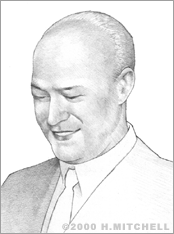Earl Tupper
By a two-step process of invention, Earl S. Tupper created one of the most practical items of Americana to date: the airtight plastic food container that still bears his name.
Earl Silas Tupper was born on a farm in New Hampshire in 1907. As a boy, he applied his native creativity to building devices that made work around the family’s farm and greenhouses easier. In fact, he earned a patent for a frame used to dress chickens for sale. The young Tupper also showed a talent for salesmanship: he increased his family’s income by selling poultry and produce door to door rather than from a stand or at the market.
A couple years after graduating from high school in 1925, Tupper set out to earn his fortune. After working for various Massachusetts operations, he decided that he could best use his agricultural experience by branching out into tree surgery and landscaping. From 1928 through the early 1930s, Tupper Tree Doctors ran a fairly successful landscaping and nursery business, until the Great Depression took its toll, forcing the company into bankruptcy in 1936.
However, in his free time Tupper had been filling notebooks with scientific inquiries, experiments, and inventions. Tupper found a job at Viscoloid, DuPont’s plastics division in Leominster, Massachusetts. Although he worked there for only one year, Tupper always considered his formal training in design, research, development and manufacturing the true beginning of his education. Tupper took this experience and founded a plastics company of his own (1938).
The Earl S. Tupper Company soon changed the bulk of its business from subcontracting for DuPont to equipping American troops with gas masks and other items for World War II. It was only after the War that Tupper decided to focus on producing plastic consumer goods. This was a challenge, because plastics were still primitive, being generally brittle, slimy and smelly --- and consumers could certainly afford to be more finicky than soldiers.
Tupper rose to the occasion first by inventing a method to transform polyethylene slag, a black, malodorous by-product of the crude oil refinement process, into a plastic that was resilient, solid, and grease-free, but also clean, clear and translucent. This was a significant step forward in itself, allowing products that would not offend a homemaker’s senses or sensibilities. But Tupper also developed an air and watertight seal, modeled on those of paint cans, for containers made of his improved plastic. This created an entirely new alternative to tin foil for the short- or long-term storage of food.
By 1946, Tupper was marketing his home products, which now came in a range of bright colors: cases for cigarettes, tumblers for the bathroom, and containers for leftovers. But despite a glowing feature in Home Beautiful magazine the next year - “Fine Art for 39¢!” - the public remained unconvinced. Then, in 1948, Tupper discovered that two Stanley Home Product sales representatives were selling a great deal of his products. Stanley salespersons introduced their products to homemakers assembled at a “party” of a hostess’ home. Mindful of his own youthful door-to-door sales success, Tupper met with several Stanley distributors to combine forces. The result was Tupperware Home Parties, which is still the exclusive distributor of Tupperware®.
By the end of the 1950s, Tupperware Parties were a national phenomenon. Even after other companies were able to imitate Tupper’s products, the “home party” sales technique guaranteed Tupperware® such a unique and preeminent status in the industry that its trademark has become practically an international generic term. When Earl Tupper sold his company for $16 million in 1958, his combined Yankee ingenuity and sales savvy had already won him a form of immortality.
Tupper passed away in Costa Rica on October 3rd, 1983 at the age of 76.


